Porcelain Insulator News
by Jack H. Tod
Reprinted from "INSULATORS - Crown Jewels of the Wire", February 1975, page 17
Preferably direct porcelain news items and questions directly to Jack H. Tod,
3427 N. 47th Place, Phoenix, Ariz. 85018. All mail will be answered if reply
stamp is enclosed, and the most newsworthy items and questions of general
interest will be published as space permits.

Les Lidtke (Meriden, Conn.) reports having a porcelain U-408, the first such
report of this one showing up. It is a tan color, top rest, mold line and with
1-3/8" pin hole.
Note that Les also reported the glass N.E.G.M. insulator just like a
porcelain U-406 (see Nov. "74 CJ, page 29). These styles plus the U-405 were
all cataloged in 1908 by New Lexington.
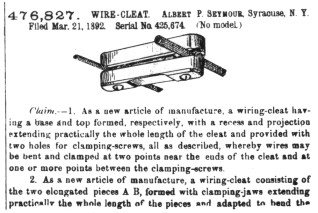 |
Image text:
476,827. WIRE-CLEAT. ALBERT P. SEYMOUR, Syracuse. N.Y. Filed Mar. 21, 1892.
Serial No. 425,674 (No model.)
Claim--1. As a new article of manufacture, a wiring-cleat having a base and
top formed, respectively. with a recess and projection extending practically the
whole length of the cleat and provided with two holes for clamping-screws, all
as described, whereby wires may be bent and clamped at two points near the ends
of the cleat and at one or more points between the clamping-screws.
2. As a new article of manufacture, a wiring-cleat consisting of the two
elongated pieces A B, formed with clamping-jaws extending practically the whole
length of the pieces and adapted to head the...
|
Errol Q. Bond (Fullerton, CA) recently sent two early Pass & Seymour
wiring cleats for my inspection.
The first one is a 3-wire non-reversible which is marked "PAT. JUNE 14,
1892 / P & S", and is covered by the patent #476,827. The base part has
a concave mating surface, including the wire grooves, and the top has a convex
surface. The top piece has
projecting studs at the sides of each groove, including a projection around the
screw holes, and there are corresponding depressions in the base piece. These
are to keep the wires in place away from the mounting screws -- much the same as
the later B & D design
The second cleat (not shown here) is a "reversible" version of
this, but a 2-wire cleat. Each piece has a convex mating surface on one end and
a concave surface on the other end. It does not have the projections at the side
of the grooves to keep the wires away from the screws. This cleat is marked with
an embossed "P & S".
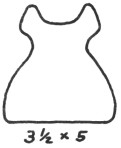
Dear Jack: Have you ever seen an insulator made of a "mica
material"? I saw this one in an antique shop last week, and it would have
been mine if I believed it were truly old. It was shaped roughly like the
enclosed sketch. Is it real? Steve Shearer,
RR #1, Box 242
Franklin, Indiana
46131
- - - - - - - - -
Dear Steve:
Yes, pin types and most other forms of insulators have been made of various
compositions including "molded mica" as Johns-Manville called theirs.
Some telegraph styles are relatively common, but cable types are not, and I have
not seen one like your sketch. You'd better believe it, they are real, and I
think you missed a goody. Hopefully, you may be able to find your way back to
that antique shop if you're now convinced.
Jack
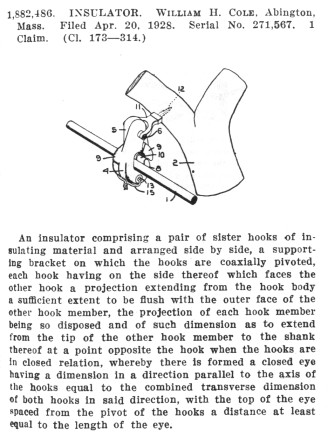 |
Image text:
1,882,486. INSULATOR. WILLIAM H. COLE Abington, Mass. Filed Apr. 20, 1928.
Serial No. 271,567. 1 Claim. (Cl. 173-314.)
An insulator comprising a pair of sister hooks of insulating material and
arranged side by side, a supporting bracket on which the hooks are coaxially
pivoted, each hook having on the side thereof which faces the other hook a
projection extending from the hook body a sufficient extent to be flush with the
outer face of the other hook member, the projection of each hook member being so
disposed and of such dimension as to extend from the tip of the other hook
member to the shank thereof at a point opposite the hook when the hooks are in
closed relation, whereby there is formed a closed eye having a dimension in a
direction parallel to the axis of the hooks equal to the combined transverse
dimension of both hooks in said direction, with the top of the eye spaced from
the pivot of the hooks a distance at least equal to the length of the eye. |
Note Frank Anderson's insulator pictured in the Jan 1975 column. This patent
(April 11, 1932) seems to fit it, so I guess we can say this in a tree
insulator.
This sheds some light on possible vintage but not on the manufacturer of it.
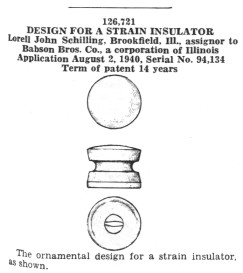 |
Image text:
126,721
DESIGN FOR A STRAIN INSULATOR Lorell John Schilling, Brookfield,
Ill., assignor to Babson Bros. Co., a corporation of Illinois Application August
2, 1940, Serial No. 94,134 Term of patent 14 years.
The ornamental design for a strain insulator, as shown. |
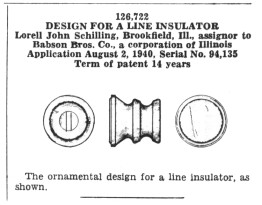 |
Image text:
126,722
DESIGN FOR A LINE INSULATOR Lorell John Schilling, Brookfield, Ill.,
assignor to Babson Bros. Co., a corporation of Illinois Application August 2,
1940, Serial No. 94,135 Tem of Patent 14 years
The ornamental design for a line insulator, as shown.
|
Note Jerry Turner's SURGE insulator shown in the January 1975 column, and
also the other porcelain SURGE in the Nov. 1971 Crown Jewels. The above two
Design Patents of April 22, 1941 cover these two insulators, and maybe if
someone cares to track down Babson's employee Schilling, we can find out more
about them--especially how the #126,721 was used as a "strain"
insulator.
Jack

Dear Jack:
I have come across a porcelain insulator that I know nothing about and which
I've sketched here (which is U-180B as shown at right). I need to get some idea
of its value so that I may trade it for some glass.
This piece is a beautiful mottled cobalt blue and in mint condition. It has
no marking.
I also have this in white except that this one has a shallow wire groove and
is embossed O-B on the edge of the dome.
Rick H. Jones
5618 Hollyhock Dr.
West Carrollton, Ohio 45449
- - - - - - - - -
Dear Rick:
Ohio Brass Co. cataloged this style for many years, and it is common in
various brown glazes. Even so, it is a very popular "hat" shape and
sells for about $2 in brown. It is also one of the shapes collected in color
sets, and the blue, white and mustard colors are a bit hard to come by. The blue
and white are about $10 items and the mustard somewhat higher. As far as I know,
it doesn't exist in green. Your shallow groove version sounds as if it would
approximate the U-180 style in the chart.
Nearly all these have the O-B marking, but weak embossings are obscured by
any heavy glaze, and you're stuck with calling it a No Name if the marking
doesn't show up. Ones without marking are naturally less desirable than ones
with a bold O-B marking.
Jack
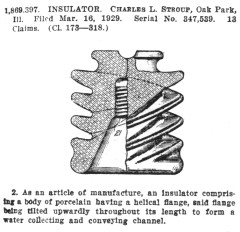 |
Image text:
1,869,397. INSULATOR, CHARLES L. STROUP, Oak Park, Ill. Filed Mar. 16, 1929.
Serial No. 347,539. 13 Claims. (CL 173--318.)
2. As an article of manufacture, an insulator comprising a body of porcelain having a helical flange, said flange being tilted upwardly throughout
its length to form a water collecting and conveying channel.
|
For all you fans of Spiral and Helical pin types, here is patent #1,869,397
of 8-2-32 (filed 3-16-29). It is interesting to note that the patent is not
assigned to Lapp whom Stroud was working for at the time of this creation or to
J-D whom he went with subsequently.
There are several other patents on this general idea in the same 1930-36 era,
one by Ohio Brass Company.
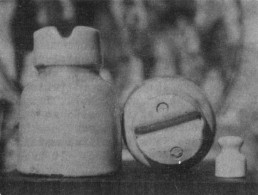
Dear Jack:
Enclosed is a photo that might be of some interest. These are insulators from
the Soviet Union; specifically they're from Riga in what used to be Latvia. They
are 4-1/4 by 2-3/4 inches and made of white porcelain.
They have an inner skirt and the threaded pin hole is somewhat smaller than
in our insulators. The embossing (on crown top, per above photo) includes a
"69" and some symbol that doesn't mean anything to me or the person
who got them for me.
Also pictured is a small porcelain knob that was taken from the same crossarm
as the other insulators. It stands about 7/8" tall.
Jim Rorobaugh
919 Drake (#131),
Davis, CA 95616
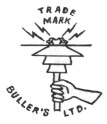
Collectors keep asking me for information about the Buller's marking shown
here, and I myself see insulators with this marking occasionally, mostly on
various beehive shapes.
This is a foreign insulator company, and I have no information on it. If any
reader can supply details on the company, we'll publish them in the column.
Matthew Hauffman (Beltsville, Md.) sent a January '74 newspaper clipping
about General Electric's insulator plant in Baltimore, and this prompted a
letter to G.E. to find out if possibly they planned to resume manufacture of pin
types again. The reply, in part:
... Yes, this operation in now called Locke Insulators, Inc., which is a joint
venture between General Electric Company and N.G.K. Industries, Ltd. The latter
company in an insulator manufacturer with headquarters in Nagoya, Japan.
We have no plans to start manufacturing pin-type insulators....

Note the marking listed for Arrow Electric Co., Hartford, Conn. on page 22 of
the Dec 1974 column. The trademark was registered (#67,282) Jan 28, 1908 and
should be corrected to that shown here.
Following is more history on porcelain manufacturers.
BOCH Porcelain
When porcelain collectors think of Boch, they usually are referring to the
BOCH PATENT #600,475 of March 8, 1898 and its importance in the early history of
pin type high-voltage insulators. That story is well known by most collectors
because of being published a number of times in insulator collector circles, but
there is more to the name Boch than just that one patent.
Mr. John W. Boch, Sr. was a ceramics expert with the R. Thomas & Sons
Company for many years, and he had other patents besides this popularly known
one. He left Thomas in 1907 and was succeeded there by his son, John W. Boch,
Jr., who was with the Thomas interests for many years, only to later ally
himself as a consulting expert with Westinghouse (at Pittsburgh).
Out of order to preserve later continuity of this story, John Boch, Sr.
became associated with Cassius M. Metsch in 1919 in the Boch-Metsch Porcelain
Co. in the manufacture of electrical and heating porcelain. This plant was
located at the northeast corner of 3rd and Harrison Sts., Newell, W. Va. -- just
across the river from East Liverpool. The history of this plant is:
| 1910 Novelty Clay Forming Co. |
Clay novelties |
| 1919 Boch-Betsch Porcelain Co. |
Elec. & heating porc. |
| 1922 Metsch Refractories Co. |
Elec. & heating porc. |
| 1973
(In operation) |
|
Boch withdrew from this operation in 1922, and the company name became Metsch
Refractories Co. It is still in operation an Metsch Refractories, Inc. with a
Chester, W. Va. address. They manufacture dry press electrical porcelain and
electrical refractory porcelain used in the electrical apparatus, controls,
appliance and heating industries. I have no knowledge of whether the Boch-Metsch
Porcelain Co. manufactured during the 1919-1922 period any
"insulators" as we collect them.
Back to when John Boch, Sr. left Thomas in 1907, he then formed his own
company for the manufacture of electrical porcelain. The plant was located at
the northeast end of 6th St., Newell, W. Va. I do not know if he made any
standard porcelain insulators there nor of any markings that can be attributed
to that company. Its history was:
| 1907 John Boch |
Electrical porcelain |
| 1937 (Moved to Klondyke) |
|
In 1937, he bought another facility in East Liverpool (Klondyke area), and
the name became Specialty Porcelain Works. Its location was the west side of
Pearl Street at Michigan & Elizabeth Streets. Its history was:
| 1895 French China Co. |
Semiporcelain |
| 1901 Smith-Phillips China Co. |
Semiporcelain |
| 1929
Amer. Chinaware Corp., Plant F |
Semiporcelain |
| 1931 Johnson China Co. |
Porcelain &
semiporc. |
| 1937 Specialty Porcelain Works (Boch) |
Electrical porc. |
I have no current information on the company, but it was still in operation
recently. This plant did make standard porcelain, and the marking on nail knobs
and #334 cleats was SPW and S.P.W. Their marking on specialty porcelain
insulators was also S. P. W'KS.
The moral of all this is that, if you can't come up with an early Thomas pin
type with the BOCH PATENT marking, you can keep your eyes open for a nail knob
marked SPW!
American Porc.
This plant was located on the southeast corner of 2nd St. and Cherry Ave.,
East Liverpool, Ohio. History is:
| 1845 Ball & Morris - Union Pottery |
Rockingham & yellow |
| 1855 McGilvary
& Orr |
Rockingham & yellow |
| 1857 Croxall & Cartwright |
Rockingham & yellow |
| 1914
American Porcelain Co. |
Electrical porcelain |
| 1932 (Operations suspended) |
|
American Porcelain was founded in 1914 with the purchase of the factory of
Croxall Pottery Co. and also that of G. W. Croxall & Sons. The product was
changed from tableware to electrical porcelain.
The founders consisted of W. J. Curry, W. A. and T. J. Andrews, formerly
owners of Adamant Porcelain Co. (1907-1915) in East Liverpool. These men were
also officers of Ohio Porcelain Co., East Liverpool, and which was bought by
General Porcelain Co. in 1913.
Some dumpage remnants remain at the old plant site, including standard
porcelain cleats and knobs marked "AMERICAN". A U-98 pin type was
found in the area, and it had a customer marking (previously reported in Crown
Jewels)
Anderson Porc.
Located south side of Harvey Ave. between Myrtle and Putnam Streets, East
Liverpool, Ohio. History is:
| 1900 Anderson Porcelain Co. |
Electrical porcelain |
| 1911 General Porcelain Co. |
Electrical porcelain |
| 1916 Louthan Mfg. Co. |
Elec. porc. & gas porcelain |
The factory was built and production started in 1900. Officers were T.F.
Anderson (Pres.), T.B. Anderson (V.P.) and G. O. Anderson (Sec-Treas). In the
beginning, only tubes, cleats and knobs were made, but in 1905 a line of pintype
and strain insulators was added.
No pin types have been found which can be definitely attributed to Anderson
Porcelain Co., but several specimens of knobs have been found in the area of the
old plant which have a marking "A. P. Co.".
The plant was bought by (merged into) General Porcelain Co. in 1911. When G.
P. Co. built their large new plant in Parkersburg, W. Va. in 1913, all its other
plants were dismantled and the equipment sent to Parkersburg. This old facility
was sold by G. P. Co. to Louthan Mfg. Co. in 1916 (formerly Louthan Supply Co.
until 1916). Louthan moved all their facilities to the Klondyke area in 1922.
Illinois Electric Porc.
This plant in located at 510 N. Pearl St., Macomb, ILL. Its history is as
follows:
| 1910 Illinois Electric Porc. Co. |
Electrical porcelain |
| 1951 (T. M. Evans,
owner) |
Electrical porcelain |
| 1953 Line Material Co., Div. of McGraw Electric Co. |
Electrical porcelain |
| 1957 Line Material Co., Div. of McGraw-Edison Co. |
Electrical porcelain |
| 1967
McGraw-Edison Power Systems Div. |
Electrical porcelain |
| 1975 (In operation) |
Electrical porcelain |
Illinois Electric Porcelain was founded by C. W. Kettron in 1910 and operated
by the Kettron family until sold to T. M. Evans in 1951.
The product was originally only dry process electrical porcelain consisting
of knobs, tubes, cleats, etc. A line of dry process pin types was also made.
Production was advertised and sold under "The Macomb Line", and the
original trademark (unregistered) was MACOMB.
The trademark was changed to Triangle-M in 1-1-15, and this was registered
(#107,575) on 12-14-15.
A trademark "BULL-DOG" was used circularly on nail knobs commencing
July 1, 1918, and this was registered (#172,397) on 8-8-23. A script form of
this trademark was also used since July 1918 and was registered (#198,982) on
6-2-25.
Later trademarks were used on wet process porcelain insulators only. One was
"ILLINOIS" registered (#502,121) on 9-14-48 and claimed in use since
Dec. 1935. Another was the "Illinois Map Outline" registered (#515,543) on 5-3-49; claimed use since 1926, but I have Illinois specimens with this
marking and dated as early an 1923.
Illinois also commenced the manufacture of wet process insulators in 1915,
including pin types and other forms of high voltage insulators. This is now the
main product.
The plant was bought by McGraw Electric Company in 1953 and operated by their
subsidiary, Line Material Co. The marking used on wet process pin types was
changed to "I.E.P." in 1954, which stood for Illinois Electric
Porcelain - and later Illinois Edison Porcelain.
In 1957 the McGraw Electric Co. merged with Thomas A. Edison Industries to
form the McGraw-Edison Co. The insulator plant become Illinois Edison Porcelain
Co., Division of McGraw-Edison Co.
The pin type marking was changed in early 1958 to incorporate the Line
Material Co. (L-M) trademark.
In May 1967 two divisions of McGraw-Edison Co. (Line, Material Industries and
Pennsylvania Transformer) merged to form McGraw-Edison Power Systems Division,
and the insulator marking was then changed to the current M/E type.
|
